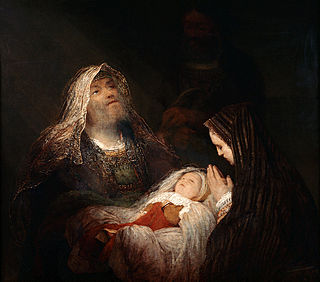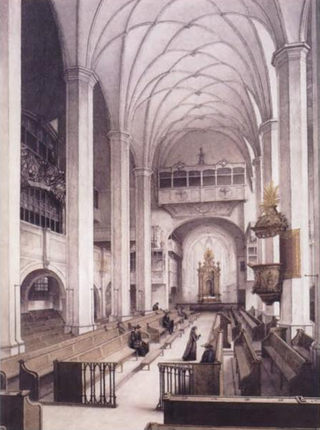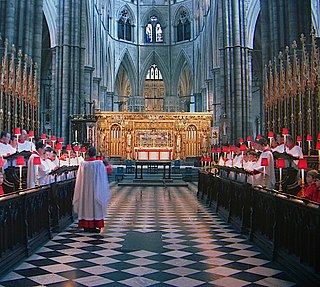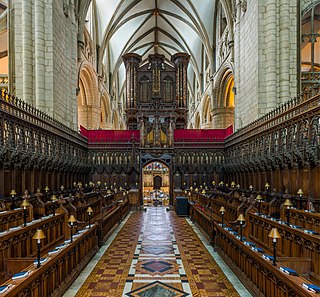Other
- "Nunc Dimittis" (short story), a short story by Roald Dahl (1953)
Nunc dimittis is a canticle from the New Testament. The canticle was often translated and set to music. Nunc dimittis and related translations may also refer to:

The Magnificat is a canticle, also known as the Song of Mary, the Canticle of Mary and, in the Byzantine tradition, the Ode of the Theotokos. It is traditionally incorporated into the liturgical services of the Catholic Church, the Eastern Orthodox Church, Lutheran Churches and the Anglican Communion. Its name comes from the incipit of the Latin version of the text.

The Nunc dimittis, also known as the Song of Simeon or the Canticle of Simeon, is a canticle taken from the second chapter of the Gospel of Luke, verses 29 through 32. Its Latin name comes from its incipit, the opening words, of the Vulgate translation of the passage, meaning "Now you let depart". Since the 4th century it has been used in Christian services of evening worship such as Compline, Vespers, and Evensong.

Sir Alfred Herbert Brewer was an English composer and organist. As organist of Gloucester Cathedral from 1896 until his death, he contributed a good deal to the Three Choirs Festival for 30 years.
Der Friede sei mit dir, BWV 158, is the shortest of the cantatas by Johann Sebastian Bach and features a bass soloist. It survives as a cantata for the third day of Easter but might be a fragment of a work originally written for Purification. Given this background, and the fact that it was copied by Christian Friedrich Penzel, one of Bach's last students, there is a confusing variety of proposed composition dates. It may date back to Bach's Weimar period, although a date as late as 1735 has been suggested.
Christian Wolff was a German baroque composer. He studied in Dresden and Leipzig and then was first kapellmeister then rector and organist in Dahlen.

Erfreute Zeit im neuen Bunde, BWV 83, is a church cantata by Johann Sebastian Bach. He wrote it in 1724 in Leipzig for the feast Mariae Reinigung (Purification) and first performed it on 2 February 1724.

Johann Sebastian Bach composed the church cantata Christus, der ist mein Leben, BWV 95 in Leipzig for the 16th Sunday after Trinity and first performed it on 12 September 1723.

Johann Sebastian Bach composed the cantata Mit Fried und Freud ich fahr dahin, BWV 125, for use in a Lutheran service. He composed this chorale cantata in Leipzig in 1725 for the feast for the Purification of Mary, which is celebrated on 2 February and is also known as Candlemas. The cantata is based on Martin Luther's 1524 hymn "Mit Fried und Freud ich fahr dahin" and forms part of Bach's chorale cantata cycle, written to provide Sundays and feast days of the liturgical year with cantatas based on a related Lutheran hymn.

Evensong is a church service traditionally held near sunset focused on singing psalms and other biblical canticles. It is loosely based on the canonical hours of vespers and compline. Old English speakers translated the Latin word vesperas as æfensang, which became 'evensong' in modern English. Typically used in reference to the Anglican daily office's evening liturgy, it can also refer to the pre-Reformation form of vespers or services of evening prayer from other denominations, particularly within the Anglican Use of the Catholic Church.

Arvo Pärt's Nunc dimittis is a setting of the Latin canticle Nunc dimittis for mixed choir a cappella, written in 2001. It was published by Universal Edition.

Mit Fried und Freud, BuxWV 76, is the common name for a piece of funeral music composed by Dieterich Buxtehude as an homage to his father in 1674. The composer named the work Fried- und Freudenreiche Hinfarth when he published it the same year. It is a bundle of two compositions, the earlier Mit Fried und Freud, BuxWV 76a, a setting of Luther's hymn Mit Fried und Freud ich fahr dahin composed in 1671 reflecting the death of Menno Hanneken, and the elegy Klag-Lied, BuxWV 76b, an aria in seven stanzas. The incipit of the elegy, "Muß der Tod denn auch entbinden", translates roughly to "Even if death must separate us". It is one of few compositions published during Buxtehude's lifetime.

"Mit Fried und Freud ich fahr dahin" is a hymn by Martin Luther, a paraphrase in German of the Nunc dimittis, the canticle of Simeon. Luther wrote the text and melody, Zahn No. 3986, in 1524 and it was first published in the same year. Originally a song for Purification, it has been used for funerals. Luther included it in 1542 in Christliche Geseng ... zum Begrebniss.

The Magnificat and Nunc dimittis for St Paul's Cathedral, also known as the St Paul's Service, is a setting by the English composer Herbert Howells of the Magnificat and Nunc dimittis for the Anglican service of Evensong. Scored for four-part choir and organ, it was written in 1950 for St Paul's Cathedral in London.

The Magnificat and Nunc dimittis for Gloucester Cathedral, also known as the Gloucester Service, is a setting by the English composer Herbert Howells of the Magnificat and Nunc dimittis for the Anglican service of Evensong. Scored for four-part choir and organ, it was written in 1946 for Gloucester Cathedral. It was published by Novello in 1947.
"Du, o schönes Weltgebäude" is a Lutheran hymn in German, with text by Johann Franck and melody by Johann Crüger. It was first published in Crüger's 1649 Geistliche Kirchen-Melodien, and was later adopted in other hymnals, such as the 1653 edition of his Praxis pietatis melica. The topic is renouncing the world, hoping to be united with Jesus. While the hymn is no longer in practical use, one stanza, "Komm, o Tod, du Schlafes Bruder", was prominently used in Bach's solo cantata Ich will den Kreuzstab gerne tragen, BWV 56; in English, it is commonly referred to as the "Kreuzstab cantata".

Magnificat and Nunc dimittis in D is a choral setting by the Irish composer Charles Wood of the Magnificat and Nunc dimittis for the Anglican service of Evening Prayer. Scored for four-part choir and organ, it was written in 1898. It is also known as Evening Service in D major.

"Im Frieden dein, o Herre mein" is a three-stanza German Christian communion hymn. In 1527 the early Reformer Johann Englisch wrote two stanzas as a rhyming close paraphase of the Nunc dimittis, or Canticle of Simeon. The hymn is sung to a melody by Wolfgang Dachstein, written before 1530. Friedrich Spitta revised the lyrics in 1898 and added a third stanza. His revision transformed Englisch's prayer of an individual with a focus on a peaceful death to a communal one more about peaceful life in unity.

Two Motets, Op. 74, are two sacred motets for unaccompanied mixed choir by Johannes Brahms, published together. Number 1, composed in 1877 in several movements, is Warum ist das Licht gegeben dem Mühseligen?, based on Biblical texts and a chorale. Number 2, composed earlier, is O Heiland, reiß die Himmel auf, containing different settings of the stanzas of Friedrich von Spee's "O Heiland, reiß die Himmel auf". The two motets were published by N. Simrock in December 1878 and dedicated to Philipp Spitta.

Collegium Regale is a collection of choral settings by the English composer Herbert Howells of the canticles for the Anglican services of Mattins, Holy Communion and Evening Prayer. Scored for four-part choir, solo tenor and organ, the pieces were written between 1944 and 1956 "for the King's College, Cambridge". The first of the pieces were first published by Novello in 1947, and they have become a popular piece of music in the Anglican church music repertoire.